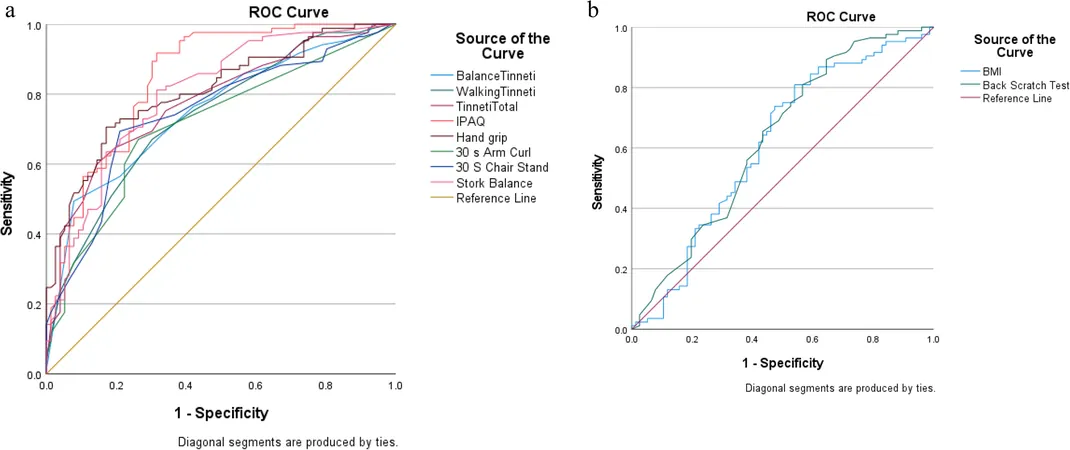
Unveiling the Link Between Mobility and Frailty in Older Adults: The Tinetti Tool Under Scrutiny
2025-03-29
Author: Mei
Introduction
As the world faces the growing challenge of an aging population, healthcare systems are struggling to adapt to the increasing need for specialized care for older adults. Central to these challenges is frailty syndrome (FS), a major concern that is garnering significant attention in geriatric research and healthcare arenas. Frailty is defined as a state of increased vulnerability, resulting from age-related declines across various physiological systems, which ultimately diminishes the ability to cope with stressors.
Physical Frailty Syndrome Model
One of the most validated methods for assessing physical frailty is the Physical Frailty Syndrome (PFS) model developed by Fried and colleagues. This model identifies frailty based on the presence of three or more criteria: unintentional weight loss, self-reported exhaustion, weakness, slow walking speed, and low physical activity levels. Understanding and diagnosing these criteria is crucial, as they significantly impact health outcomes and healthcare costs. Recent studies have illustrated that frail older adults can incur healthcare costs almost double those of non-frail individuals, highlighting the importance of addressing FS in public health strategies.
Prevalence and Importance of Early Detection
Given that PFS affects a staggering 4% to 59.1% of individuals over 60, effective intervention strategies are urgently needed. Poor mobility, including issues with balance and gait, are closely linked to the onset of frailty. Therefore, early detection of physical frailty using accessible, low-cost tests is essential in promoting healthier aging and facilitating independence among senior populations.
The Tinetti Performance-Oriented Mobility Assessment
The Tinetti Performance-Oriented Mobility Assessment (POMA) has emerged as a popular tool for evaluating balance and gait in older adults. Its dual focus on these critical components makes it particularly effective in predicting frailty and identifying those at risk for falls. A recent study aimed to assess the predictive value of the Tinetti POMA score in differentiating between frail and non-frail older adults.
Study Overview and Findings
Conducted in Tehran, the study included 161 community-dwelling seniors aged 60 and above, with a diverse demographic profile. The researchers utilized the Tinetti POMA, alongside other physical functional fitness tests, including handgrip strength and balance assessments, to explore their associations with PFS. Initial findings indicated significant disparities in scores between frail individuals and their non-frail peers, reinforcing existing literature on the functional impairments associated with frailty.
Key Insights
Results emphasized that balance and strength are crucial markers in frailty assessment. Poor performance on physical function tests, including sit-to-stand and handgrip strength, was linked to higher frailty risk, corroborating previous studies highlighting the vital role of muscle and functional performance in everyday activities.
Clinical Implications and Future Directions
The study's results are promising, establishing that the Tinetti POMA may not only serve as a reliable tool in identifying frailty but also aid in developing targeted interventions aimed at improving mobility and reducing healthcare costs associated with frailty. Moreover, the use of predictive analytics, such as logistic regression and ROC curves, allowed researchers to identify optimal cutoff points for various assessments, significantly enhancing the tool's clinical utility.
Limitations and Considerations
However, the study is not without limitations. Its cross-sectional design restricts the understanding of cause-and-effect relationships, and its focus on a specific population may hinder generalizability. Future research should employ longitudinal designs, consider diverse populations, and integrate advanced technology like wearable devices to measure physical activity levels more accurately.
Conclusion
As the healthcare community continues to grapple with the implications of an aging population, the identification and management of frailty will become increasingly vital. Tools like the Tinetti POMA represent a critical step in the right direction, providing healthcare practitioners with the means to implement preventative strategies, thereby promoting healthier lifestyles and enhancing the quality of life for older adults.
Ongoing Research and Future Outlook
Stay tuned as the conversation around older adults and frailty continues to unfold, with ongoing research promising to shed light on this pressing health concern!




 Brasil (PT)
Brasil (PT)
 Canada (EN)
Canada (EN)
 Chile (ES)
Chile (ES)
 Česko (CS)
Česko (CS)
 대한민국 (KO)
대한민국 (KO)
 España (ES)
España (ES)
 France (FR)
France (FR)
 Hong Kong (EN)
Hong Kong (EN)
 Italia (IT)
Italia (IT)
 日本 (JA)
日本 (JA)
 Magyarország (HU)
Magyarország (HU)
 Norge (NO)
Norge (NO)
 Polska (PL)
Polska (PL)
 Schweiz (DE)
Schweiz (DE)
 Singapore (EN)
Singapore (EN)
 Sverige (SV)
Sverige (SV)
 Suomi (FI)
Suomi (FI)
 Türkiye (TR)
Türkiye (TR)
 الإمارات العربية المتحدة (AR)
الإمارات العربية المتحدة (AR)